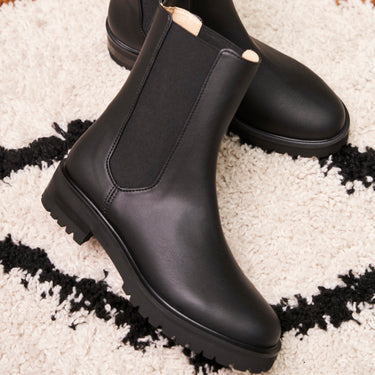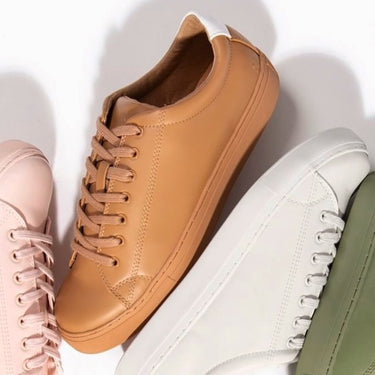How to Switch to Ethical & Sustainable Fashion?
“Ethics” and “sustainability” are fashion industry buzzwords – you're likely to see these terms in fashion media on an almost daily basis describing materials, production practices, and entire ranges. But as brands use these terms to market everything from new collections to charity initiatives, few people really have an idea of what these words actually mean, and how to know if something you're buying is really ethical or sustainable.
By Sascha Camilli: writer, speaker, activist and vegan fashion expert.
Fashion Revolution Week takes place in April – a time to remember the day when over 1300 garment workers lost their lives in the collapse of the Rana Plaza garment factory in Dhaka, Bangladesh. Since that fateful day, fashion campaign organisation Fashion Revolution has campaigned for more transparency and increased rights for garment workers all over the world, encouraging fashion consumers all over the world to ask their favourite brands “who made my clothes?"
Fashion Revolution, along with other organisations, plays a votal role in demanding a more ethical and sustainable fashion industry. But those words can often be confusing for consumers to understand.
There is a reason for this confusion: there isn't a set definition of what “ethical” and “sustainable” fashion really entails, and there is nothing really governing what can be defined ethical and sustainable, which makes it easy for brands and media to use these terms arbitrarily. So how do you know whether a purchase is truly ethical?
What is ethics in fashion?
It's crucial to be realistic and keep in mind that it's impossible for anyone – including brands – to be 100% ethical at all times, in every step of their process. Some level of harm is inevitable for all of us, and it can be argued that just producing fashion, in any way, is unsustainable. But having said that, it's absolutely crucial at this time in history that we pay attention to production practices and learn more about where our clothes come from, for a kinder and more conscious fashion industry.
Sometimes ethical fashion is described as fluid because “ethics are personal”. But are they really? If we think about it, it's pretty easy for most of us to discern between what's universally right and wrong – we just don't always make the effort to do so because of convenience, habit, or societal pressure. There is objectively no defence for modern slavery, animal cruelty, or destroying the planet for vanity. People might have differing opinions on what is ethical, but we largely agree on what is unethical.
Human rights
Very commonly, the ethics of fashion are determined by how well a company treats its workers. Fair living wages, suitable working conditions and humane hours are just a few of the criteria that a brand that cares about human rights is expected to pay attention to – the urgency of these issues is highlighted by tragedies such as the Rana Plaza disaster. By most people's definition, you cannot be an “ethical” brand without paying careful attention to human rights issues.
This is particularly true in the current climate: the COVID-19 pandemic has left many garment workers – who were already living and working in very difficult conditions – in an even more desperate situation: as brands are cancelling orders from factories, some are refusing to pay for orders that they already made. Many workers are paid on delivery, and companies are now laying off staff, which means that fragile workers have nowhere to turn and are unsure of how to survive. Other coronavirus-related issues for workers include difficulties with practicing social distancing and accessing sanitiser and protective equipment (such as masks and gloves) while working, which has been reported to be the case in several fashion brands' warehouses.
Animal rights
Animal rights are also a huge concern for most – especially millennials. A report by Bain & Co found that animal rights stands out as a key factor of concern for the lucrative millennial demographic. Fur is basically a no-go in today's woke fashion industry: big-name brands who used to be supporters of the trade, such as Prada, Chanel, Burberry and Gucci, are now fur-free. Leather is also falling out of favour: the 2020 Lyst Conscious Fashion Report has showed that searches for “vegan leather” have increased by 69% year-on-year, and in 2019, Helsinki Fashion Week had its first completely leather-free event. For more and more people, using animals for fashion is increasingly incompatible with ethics.
Environmental sustainability
Environmental concerns are at an all-time high due to the current climate crisis – and with fashion constantly being found to be one of the most polluting industries on the planet, environmental sustainability is one of the most prominent topics connected to the conversation around ethical fashion. Water waste, pesticide use, air and water pollution, and microplastics present in synthetic clothing stand out as topics that may suggest that a garment is in fact unsustainable. Fashion is also a huge contributor to climate change. Every year, the garment industry emits 1.2 billion tons of greenhouse gases – more than marine shipping and international flights combined. So to be truly considered sustainable, a company has to consider its contribution to the issues that are currently wreaking havoc on our planet.
A good way for a company to venture into sustainability is to consider the materials used. Plastic pollution isn't just a packaging problem – it's also a garment problem. Approximately 60% of all textiles in the world are made from fibres that come from plastic, like polyester, acrylic, nylon, and the worst offender of them all, PVC. There are many issues connected to these materials, including the fact that they don't biodegrade and that their production can be very toxic. Another issue that users and producers of synthetics must consider is microplastics: when synthetics are washed, they release tiny plastic particles into the waterways. These plastic particles contaminate the environment and are harmful to marine animals. A good way to combat this is to use a washbag that captures microplastics and lessens the quantity of particles being released.
A bigger problem is the leather trade – arguably the most polluting material in fashion, leather kills one billion animals every year and is highly toxic due to chemicals such as formaldehyde and chromium frequently used in its production. But in case you hear of a so-called “sustainable” brand talking about their “chrome-free” or “vegetable-tanned” leather, don't be fooled. As much as 93% of the environmental damage of leather occurs before the tannery stages, due to the astronomical environmental cost of raising animals for fashion. This is why the 2017 Pulse of Fashion Industry Report put leather at the top of its list of the most polluting materials in fashion, which has prompted the development of more planet-friendly, animal-free materials like leather made from apples and pineapples.
But no matter what steps the industry takes to improve their production practices, one fact remains: producing and consuming as much as we currently are can never be ethical or sustainable. The system that churns out as many as 50 different collections per brand and year has to be dismantled for a new, slower, more conscious system. When it comes to our wardrobes, few things are as ethical and sustainable as loving your clothes, cherishing them, and making them last.
By Sascha Camilli
About Sascha
Sascha Camilli is a vegan fashion writer, speaker and activist. Her book Vegan Style is out now on Murdoch Books. For more about Sascha, you can read our interview with her. You can also follow her on Instagram, Twitter and LinkedIn.
For more articles like this in your inbox, sign up to our newsletter, and get up to 20% off your next purchase.
Cover image by blisko
































































